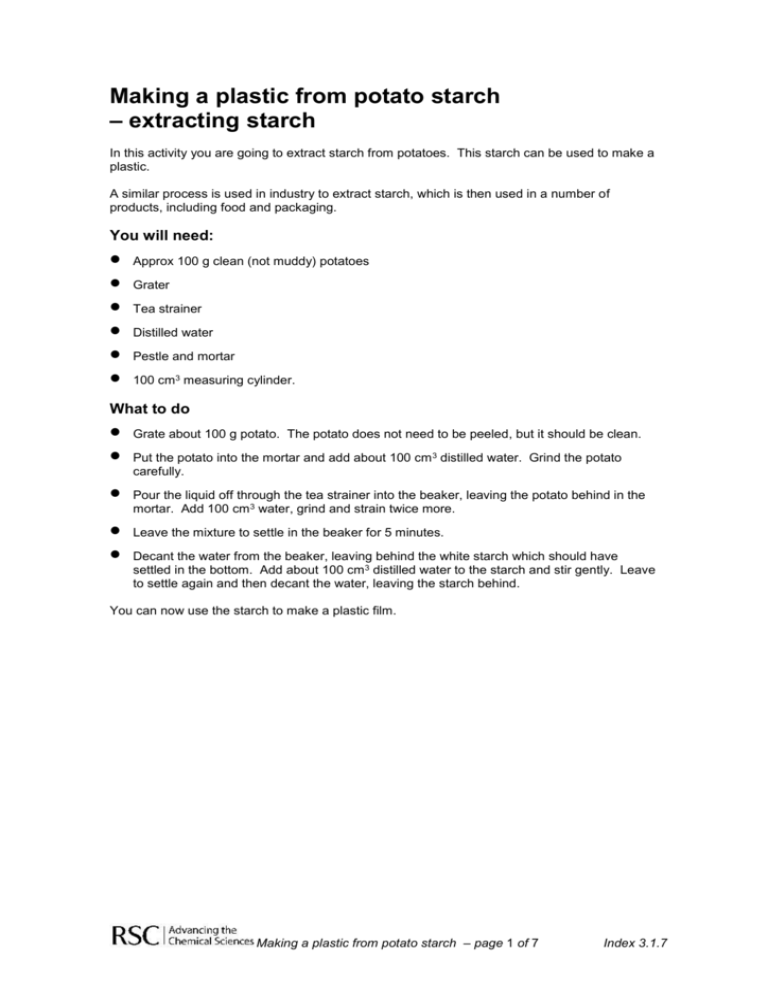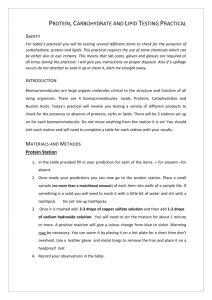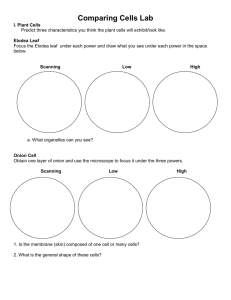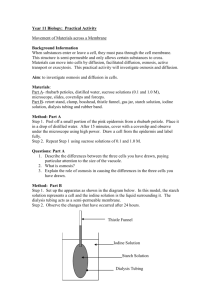Making a plastic from potato starch – extracting starch
advertisement

Making a plastic from potato starch – extracting starch In this activity you are going to extract starch from potatoes. This starch can be used to make a plastic. A similar process is used in industry to extract starch, which is then used in a number of products, including food and packaging. You will need: Approx 100 g clean (not muddy) potatoes Grater Tea strainer Distilled water Pestle and mortar 100 cm3 measuring cylinder. What to do Grate about 100 g potato. The potato does not need to be peeled, but it should be clean. Put the potato into the mortar and add about 100 cm 3 distilled water. Grind the potato carefully. Pour the liquid off through the tea strainer into the beaker, leaving the potato behind in the mortar. Add 100 cm 3 water, grind and strain twice more. Leave the mixture to settle in the beaker for 5 minutes. Decant the water from the beaker, leaving behind the white starch which should have settled in the bottom. Add about 100 cm 3 distilled water to the starch and stir gently. Leave to settle again and then decant the water, leaving the starch behind. You can now use the starch to make a plastic film. Making a plastic from potato starch – page 1 of 7 Index 3.1.7 Making a plastic from potato starch – making the plastic In this activity you will make a plastic film from potato starch and test its properties. Potato starch is a polymer made of long chains of glucose units joined together. It actually contains two polymers: Amylose, which is a straight chain of glucose units Amylopectin, which is a branched polymer, also made of glucose units. The amylopectin prevents the starch from becoming plastic-like. You will use hydrochloric acid to break down the amylopectin and change the stucture and properties of the polymer. You will make two different batches of the potato plastic. In one you will add some propan1,2,3-triol (also known as glycerol), which will act as a plasticiser. In the other batch, you will leave the propan-1,2,3-triol out. Making the potato plastic You will need: 250 cm3 beaker Large watch glass Bunsen burner and heat proof mat Tripod and gauze Stirring rod Potato starch Propan-1,2,3-triol Hydrochloric acid 0.1 mol/dm 3 (Minimal hazard) Sodium hydroxide 0.1 mol/dm 3 (Irritant) Food colouring Petri dish or white tile Universal Indicator paper Eye protection Access to a balance 25 cm3 measuring cylinder 10 cm3 measuring cylinder. Health and safety Wear eye protection. Propan-1,2,3-triol may be harmful if ingested in large quantities. Making a plastic from potato starch – page 2 of 7 Index 3.1.7 What to do Put 25 cm3 water into the beaker and add 2.5 g potato starch, 3 cm 3 hydrochloric acid and 2 cm3 propan-1,2,3-triol. Put the watch glass on the beaker and heat the mixture using the Bunsen burner. Bring it carefully to the boil and then boil it gently for 15 minutes. Make sure it does not boil dry – if it looks like it might, then stop heating. Dip the glass rod into the mixture and dot it onto the indicator paper to measure the pH. Add enough sodium hydroxide solution to neutralise the mixture, testing after each addition with indicator paper. You will probably need to add about the same amount of sodium hydroxide as you did acid at the beginning (3 cm 3). If you wish you can add a drop of food colouring and mix thoroughly. Be careful not to spill the food colouring – it stains. Pour the mixture onto a labelled petri dish or white tile and push it around with the glass rod so that you have an even covering. Label your mixture and leave it to dry out. This will take about 1 day on a radiator or sunny windowsill or two days at room temperature. Repeat the steps described above, but leave out the propan-1,2,3-triol. Make sure you label your mixtures so that you know which one contains propan-1,2,3-triol and which does not. Making a plastic from potato starch – page 3 of 7 Index 3.1.7 Making a plastic from potato starch – examining your plastic Look carefully at your two petri dishes containing potato plastic. 1. Describe carefully the properties of each of the substances you have made. 2. What difference has adding the propan-1,2,3-triol made? The propan-1, 2, 3-triol is acting as a plasticiser. Plasticisers are used in commercial products to change the properties of the polymer, just as you have used the propan-1,2,3-triol to change the properties of the potato plastic. The propan-1,2,3-triol gets in between the polymer chains and prevents them from lining up in rows to form a crystalline structure. When the polymer becomes crystalline, it also becomes brittle and inflexible. You can think of the plasticiser as a small molecule that gets between the polymer chains and helps them to slide easily over each other so that the polymer behaves like a plastic. 3. Draw a diagram of the polymer chains with and without the propan-1,2,3-triol and use it to help you explain why the potato plastic has very different properties when propan1,2,3-triol is present. Label which one is which. Use a simple line like this to represent a polymer chain: and like this to represent propan-1,2,3-triol. Making a plastic from potato starch – page 4 of 7 Index 3.1.7 Using plastics from potato starch 1. Do you think the plastic you made from potato starch will be biodegradable? Explain your answer. 2. How could you test your plastic to find out? Extracting starch from potatoes takes a lot of energy. You had to grate the potatoes, grind them and rinse them several times. Similar processes are used in industry to extract starch, although sweetcorn (maize) is used more often than potatoes. The leftover bits are often used in animal feed so that none of the material is wasted. 3. In industry, where would the energy needed to extract the starch come from? 4. What are most plastics made from? (What is the raw material used to make them?) Plastics made from plants or other living things are known as bioplastics. ‘Bioplastic’ does not mean the same thing as ‘biodegradable plastic’. Some biodegradable plastics are made from oil and some bioplastics are not biodegradable. 5. Explain the meaning of the terms bioplastic and biodegradable. 6. Write a list of the advantages of making plastics for which the raw material comes from plants. 7. What are the disadvantages? (Hint: think about growing the plants.) Making a plastic from potato starch – page 5 of 7 Index 3.1.7 Your starch plastic will dissolve in water if you leave it overnight. 8. What effect will this solubility have on the number of things that this plastic can be used for? Write down three things for which it could not be used and some things for which it could. To try to make starch more useful, researchers have tried blending it with other plastics like polythene. They hoped that this would make the overall product more biodegradable than polythene on its own. Unfortunately, this was not the case. The plastic tended to fall to bits but the pieces were less biodegradable than ordinary starch. More recently, a scientist called Catia Bastioli from Italy has taken starch treated in the same way that you have treated it (with acid and propan-1,2,3-triol) and mixed it with the polymer PVA (used in white glue). The polymer that results is biodegradable but also water soluble. This means that its use is limited to things like packing dry goods, or replacing polystyrene foam, which is not biodegradable and is made from oil. The method used to turn the starch into small pieces of foam packaging material is similar to the technique used to make foods such as Rice Krispies and Coco Pops. Price list Name of product Starch/PVA blend polythene polystyrene 9. Price in £ per kg 3.40–4.40 0.50–0.60 0.60 The letter overleaf was sent to a magazine. The editor does not know much about science and so has asked you to write a reply to be published in the next edition. Make sure that your reply: Uses accurate scientific information Is clear and concise Answers the question. You may find the following websites helpful when researching your answer. If you use information from a website, do not forget to think about whose website it is and if it is likely to be biased. If so, what effect this bias might have on the information on the site. http://www.greenlightproducts.co.uk http://www.friendlypackaging.org.uk http://www.foe.co.uk/resource/factsheets/plastics.pdf – if you have difficulty with this web address, go to http://www.foe.co.uk and follow the links to the plastics factsheet (All websites accessed in November 2005.) Making a plastic from potato starch – page 6 of 7 Index 3.1.7 Dear Editor I try to be as environmentally-friendly as I can and I like to encourage others to do the same. I found out recently that it is possible to make plastics out of starch from plants, but most plastics are still made out of oil. I am horrified and wondered if you know why this is? Yours sincerely Anne Other Making a plastic from potato starch – page 7 of 7 Index 3.1.7








